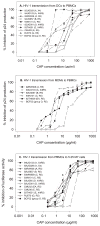Cellulose acetate 1,2-benzenedicarboxylate inhibits infection by cell-free and cell-associated primary HIV-1 isolates
- PMID: 16706617
- PMCID: PMC2788998
- DOI: 10.1089/aid.2006.22.411
Cellulose acetate 1,2-benzenedicarboxylate inhibits infection by cell-free and cell-associated primary HIV-1 isolates
Abstract
Cellulose acetate 1,2-benzenedicarboxylate (CAP), a pharmaceutical excipient used for enteric film coating of capsules and tablets, was previously shown to have potent inhibitory activity against infection by human immunodeficiency virus type 1 (HIV-1) T cell line-adapted (TCLA) strains. In the present study, we determined the inhibitory activity of CAP against infection by cell-free and cell-associated primary HIV-1 isolates with distinct genotypes and biotypes in cervical explants, peripheral blood mononuclear cells (PBMCs), monocytederived macrophages (MDMs), and CEMx174 5.25M7 cells. CAP blocked infection by cell-free and cell-associated HIV-1 in cervical explants. It inhibited infection by cell-free primary HIV-1 isolates (clades A to G and group O) in PBMCs, MDMs, and CEMx174 5.25M7 cells and blocked transmissions of the cell-associated primary HIV-1 isolates from dendritic cells (DCs) to PBMCs, from MDMs to PBMCs, and from PBMCs to CEMx174 5.25M7 cells. The inhibitory activity of CAP on infection by the cell-free and cell-associated primary HIV-1 isolates is independent of viral subtypes and coreceptor usage. These data suggest that CAP is a good microbicide candidate that can be further developed for preventing sexual transmission of HIV-1.
Figures



References
-
- Alexander NJ. Sexual transmission of human immunodeficiency virus: Virus entry into the male and female genital tract. World Health Organization, Global Programme on Acquired Immune Deficiency Syndrome. Fertil Steril. 1990;54:1–18. - PubMed
-
- Merson MH. Slowing the spread of HIV: agenda for the 1990s. Science. 1993;260:1266–1268. - PubMed
-
- D’Cruz OJ, Uckun FM. Clinical development of microbicides for the prevention of HIV infection. Curr Pharm Des. 2004;10:315–336. - PubMed
-
- Vernazza PL, Eron JJ, Cohen MS, van der Horst CM, Troiani L, Fiscus SA. Detection and biologic characterization of infectious HIV-1 in semen of seropositive men. AIDS. 1994;8:1325–1329. - PubMed
Publication types
MeSH terms
Substances
Grants and funding
LinkOut - more resources
Full Text Sources
Medical
Miscellaneous

